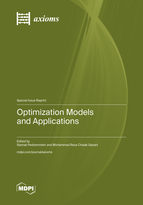Optimization Models and Applications
A special issue of Axioms (ISSN 2075-1680). This special issue belongs to the section "Mathematical Analysis".
Deadline for manuscript submissions: closed (30 November 2023) | Viewed by 15661
Special Issue Editors
2. Faculty of Design, Tabriz Islamic Art University, Tabriz, Iran
Interests: structural modeling and dynamics; mechanical vibrations and modal analysis; data analysis and optimization; parallel mechanisms and machine tool design; nanocomposite FSP/FSW
Interests: motion cueing; manipulator; AI in manufacturing
Special Issue Information
Dear Colleagues,
Optimization models have been widely used in applications across many fields, including engineering, economics, environment, health, systems of systems, business, etc. Optimizations can be divided into four groups: physic-based optimization algorithms, swarm-based optimization algorithms, game-based optimization algorithms, and evolutionary-based optimization algorithms. Optimization models have been implemented intensively in different applications over the last fifty years. This Special Issue will focus on the connection between optimization models and their applications to solve the basic science real-world problem.
We cordially and earnestly invite researchers to contribute their original and high-quality research papers, which will inspire advances in optimization and their applications. The scope of this Special Issue includes, but is not limited to:
- Functional analysis;
- Critical point theory;
- Bifurcation theory;
- Set-valued analysis;
- Calculus of variations and PDEs;
- Variational and topological methods for ODEs and PDEs;
- Fixed point, coincidence point, and best proximity point theory;
- Non smooth analysis and optimisation;
- Graph theory and optimisation;
- Game theory;
- Convex analysis;
- Matrix theory;
- Control theory;
- Inverse and ill-posed problems;
- Finite element method;
- Dynamical systems;
- Image and signal processing;
- Data mining;
- Update quality of products;
- Reinforcement learning;
- Cost-effective mathematical model.
Dr. Siamak Pedrammehr
Dr. Mohammad Reza Chalak Qazani
Guest Editors
Manuscript Submission Information
Manuscripts should be submitted online at www.mdpi.com by registering and logging in to this website. Once you are registered, click here to go to the submission form. Manuscripts can be submitted until the deadline. All submissions that pass pre-check are peer-reviewed. Accepted papers will be published continuously in the journal (as soon as accepted) and will be listed together on the special issue website. Research articles, review articles as well as short communications are invited. For planned papers, a title and short abstract (about 100 words) can be sent to the Editorial Office for announcement on this website.
Submitted manuscripts should not have been published previously, nor be under consideration for publication elsewhere (except conference proceedings papers). All manuscripts are thoroughly refereed through a single-blind peer-review process. A guide for authors and other relevant information for submission of manuscripts is available on the Instructions for Authors page. Axioms is an international peer-reviewed open access monthly journal published by MDPI.
Please visit the Instructions for Authors page before submitting a manuscript. The Article Processing Charge (APC) for publication in this open access journal is 2400 CHF (Swiss Francs). Submitted papers should be well formatted and use good English. Authors may use MDPI's English editing service prior to publication or during author revisions.






